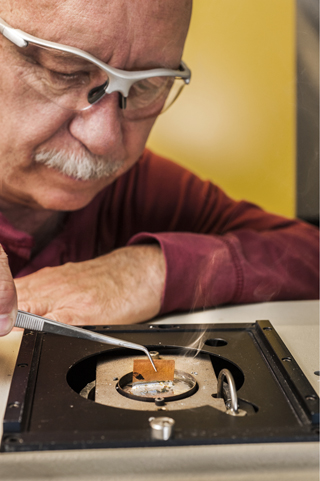
Sandia’s Jerry Rejent (1831) applies lead-free solder to a metal. The solder is hardy, environmentally safe, and low-temperature, and has been sold all over the world. (Photo by Randy Montoya)
The simplest products sometimes offer the widest applications. So seems the case with lead-free solder, Sandia’s simplest yet highest grossing patent. It was granted in 1996 to Sandia, Ames Laboratory, and Iowa State University, and brought millions of dollars back to taxpayers before it ran out in July.
According to Sandia senior manager Mark F. Smith (1830), US Patent 5,527,628 came about because government tests showed that lead-based solder in discarded materials “oxidized, turned to powder, was driven into the ground by rain and snow, and found its way to local aquifers.”
But lead-free solders of the time put electronic fabrication techniques at risk because they required melt temperatures higher than Sandia, and industry, could tolerate.
Sandia researcher Fred Yost (ret.) mentioned this problem to his former PhD advisor, ISU professor J.F. Smith (and Mark Smith’s father), visiting Sandia on a consulting contract. The elder Smith said that there was a region of the tin-silver-copper phase diagram that “looked funny” to him, and he asked Iver Anderson at Ames Lab to collect more data on this alloy. These new data revealed a melting point only slightly higher than the traditional leaded-solder melting point, 217°C vs. 188°C.
Sandia tested the properties of the new solder. When it appeared on the market — hardy, environmentally safe, and low-temperature — it was bought all over the world. —Neal Singer